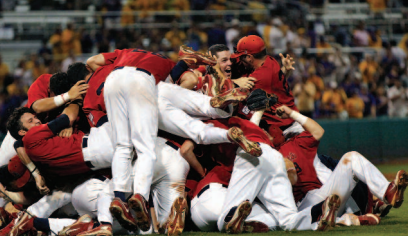
The Rating Percentage Index (RPI) was adopted by the NCAA many years ago with the intent to rank teams based on their strength of schedule. Recommended changes to the RPI formula have been approved by the Division I Baseball Committee and will take effect at the start of the 2013 season. It will still be calculated using three statistical parameters:
1. Division I winning percentage (25%)
2. Opponent's Division I winning percentage (50%)
3. Opponents' opponents' Division I winning percentage (25%)
The new formula will value each home win as 0.7 and each road victory as 1.3, a change from the customary 1.0 of the past. Conversely, each home loss will be weighted as 1.3, and each road loss will count 0.7 against a team's RPI.
Neutral site games will continue to be weighted the same value of 1.0.
The new method is not quite as extreme as basketball's (1.4 for home losses and road wins, 0.6 for home wins and road losses), but the overriding factor with baseball is that the vast majority of games are played outside. Further, baseball schedules are also filled with three-game series as opposed to single games against opponents.
"To be honest the whole thing is a little confusing to me, we just try to go out and win every game we play," said Clemson head coach Jack Leggett. "They showed us what it would be with the new RPI and what is was before and it wasnt that big of a difference."
Leggett is right; in 2011, Clemson finished ranked No. 7 in the RPI, and would have stayed there if the new RPI had already been implemented. For the most part, "southern" schools from BCS conferences weren't affected by the change. So who was?
The adjusted winning percentage was exemplified in a breakdown of 2011 RPI's in college baseball. Inside Pitch researched the breakdown and found the following facts:
Of the 58 teams who dropped 10+ spots:
• Ten were from BCS conferences (at the time)
• States with the most schools that dropped ten or more spots in the RPI were California, Tennessee, North Carolina, South Carolina (all with six), Louisiana and Texas (both with five)
• Tennessee (-32), Duke (-31), Lipscomb (-28), McNeese State (-27), Tulane (-25) and the Citadel (-25) all fell 25 spots or more
Of the 48 teams who gained 10+ spots:
• Eight were from BCS conferences (at the time)
• States with the most schools that gained ten or more spots in the RPI were New York (with eight), Illinois and Indiana (four each)
• California (+42), Alcorn State (+41), Central Michigan (+34), South Dakota State (+31), Maine (+31), Purdue (+28), Binghamton (+27), Southern Illinois (+27), Utah (+26), Le Moyne (+26) and Princeton (+25) all jumped 25 spots or more
It comes to no surprise that the RPI change is certainly a win for northern schools that typically travel south for the early parts of their season, ensuring the best possible weather for their season openers. However, it seems that many "mid-major" southern schools – who are already members of predominately one-bid conferences in terms of the NCAA postseason – will be negatively affected.
While most head coaches are typically more focused on who their Sunday starter will be at this point in the year, it will be interesting to see the effect that the new RPI formula will have on the landscape of our game. Of the sixteen teams that qualified for Super Regionals last year, four (Kent State, Oregon, St. John's (NY) and Stony Brook) were from what could be considered "cold weather states."
The 2011 RPI comparison chart can be found online at
http://www.ncaa.com/content/baseball-rpi-comparison